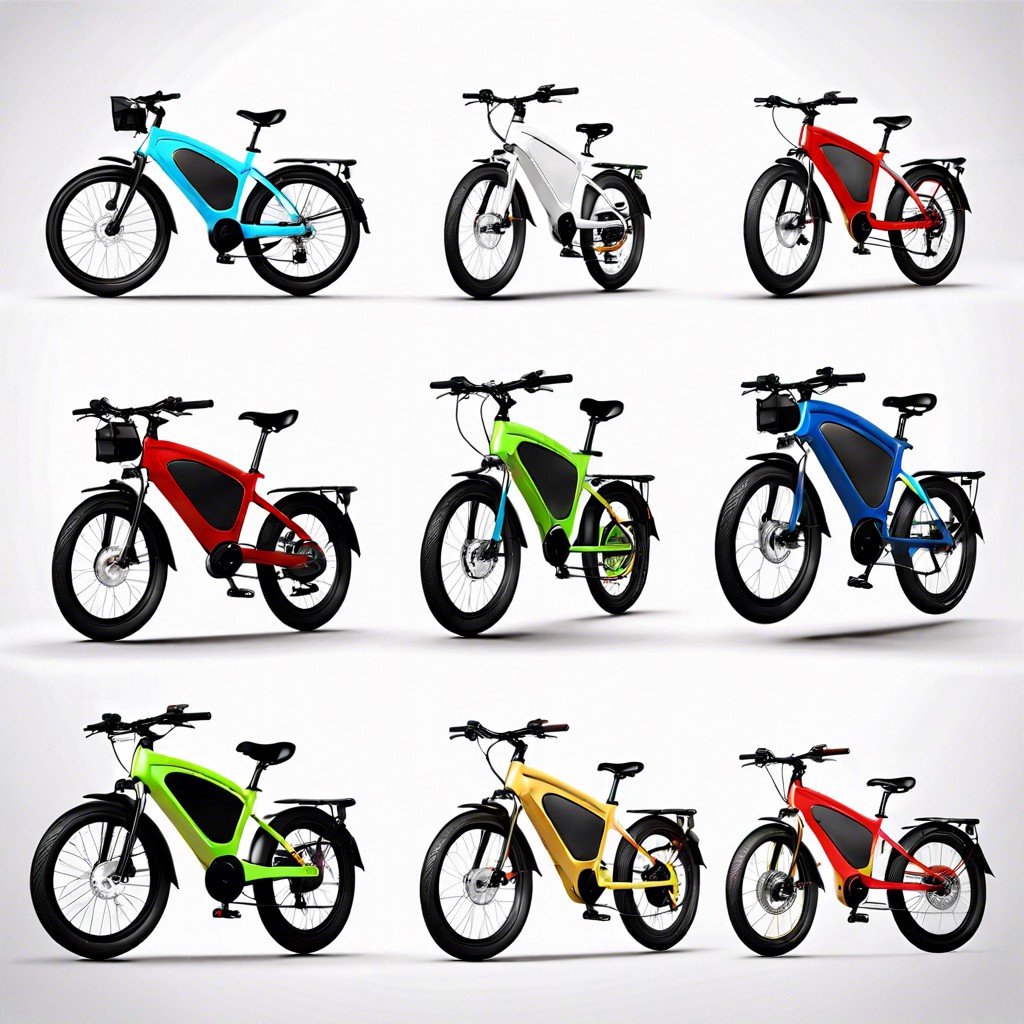Uncover the factors that influence the speed of electric bikes and learn what determines their top velocity.
Key takeaways:
- Electric bikes are classified into three types based on speed range.
- Class 1 e-bikes provide pedal assistance up to 20 mph.
- Class 2 e-bikes have a throttle and top speed of 20 mph.
- Class 3 e-bikes offer pedal assistance up to 28 mph.
- Factors that affect e-bike speed include motor power, battery capacity, weight, skill level, and aerodynamics.
Different Types of Electric Bikes and Their Speed Range

Electric bikes, often termed e-bikes, fall into three classifications that dictate their maximum assisted speeds. Class 1 e-bikes provide pedal assistance up to 20 mph (32 km/h), a feature that ceases once this limit is reached, fostering a blend of exercise with an added boost. Ideal for those seeking a gentle lift on their ride, these bikes are welcomed on most bike paths and trails.
Class 2 models share the 20 mph cap but differ by offering a throttle, enabling riders to engage the motor assistance without pedaling, a convenience for those preferring not to exert much physical effort during their commute or ride. This feature positions Class 2 e-bikes closer to motorized vehicles, though still maintaining the bicycle’s accessibility and ease-of-use.
The Class 3 category pushes the assisted speed boundary to 28 mph (45 km/h) exclusively through pedal assistance. Designed for more experienced riders, these high-performance e-bikes cater to longer commutes and cutting down travel time, all while requiring a more engaged riding approach. It is important to note that their increased capabilities mean they may not be permitted on certain paths where lower-speed e-bikes are allowed.
Class 1 Electric Bikes
Class 1 e-bikes, also known as pedal-assist bikes, require the rider’s pedaling effort to engage the electric motor. The motor amplifies your pedaling up to a maximum speed of 20 mph, offering a natural riding experience that’s akin to traditional cycling but with less strain. It’s important to note that the motor ceases to provide assistance when you reach this speed limit, ensuring safe and legal riding, particularly on bike paths and in urban environments.
Due to their design, these e-bikes promote physical activity, as the motor only kicks in to assist, not to completely take over the riding process. Furthermore, their widespread acceptance makes them a preferred choice in many regions, allowing access to most trails and paths where conventional bikes are allowed. This classification of e-bike serves as an excellent option for those seeking moderate exercise while enjoying the benefits of electric power-assist technology.
Class 2 Electric Bikes
Class 2 e-bikes offer the added convenience of a throttle, which provides power on demand and allows riders to travel without pedaling. These bikes cap their speeds at 20 mph to adhere to safety standards and regulations.
The throttle mechanism makes them ideal for commuters who may want a break from pedaling or need an immediate boost to navigate traffic. It’s crucial to note, however, that constant use of the throttle will deplete the battery faster than pedal-assisted modes.
While they share the same speed limit as Class 1 e-bikes, Class 2 models provide a distinct hands-off approach to cycling, appealing to those seeking a more relaxed ride, while still maintaining the fitness benefits if the rider chooses to pedal.
Despite their motorized capabilities, Class 2 e-bikes can still be used on most bike paths, but it’s essential for riders to verify local regulations as some areas may restrict the use of throttle-operated bikes on specific trails or in certain zones.
Class 3 Electric Bikes
Class 3 e-bikes, often referred to as “speed pedelecs,” support rider input with an electric assist up to 28 mph. Central to their appeal is the perfect balance between exertion and support. This speed boost aligns well with urban commuting, where cyclists share roads with faster-moving traffic.
These bikes feature more robust motors, typically around 250 to 750 watts, which directly influence their swift acceleration. However, the increased speed capability comes with a regulation caveat: most jurisdictions require riders to be at least 16 years of age and mandate the use of helmets.
Their design often includes advanced safety features, such as integrated lighting and braking systems that are engineered to handle higher traveling speeds. Enhanced performance also means that Class 3 bikes are commonly equipped with higher capacity batteries to maintain assist across longer distances, making them a top choice for longer commutes or tours.
Despite their speed, these e-bikes maintain the pedal-assist mechanism, meaning the motor engages only when the rider is pedaling, promoting a cycling experience that feels natural yet amplified.
Factors That Affect Electric-bike Speed
Motor power, expressed in watts, significantly impacts achievable speeds on an electric bike. A higher wattage correlates to more robust propulsion, allowing for quicker acceleration and higher top speeds, given other factors are constant.
Battery capacity, measured in ampere-hours (Ah), also plays a role. A larger capacity means a bike can sustain its peak power output for longer periods before requiring a recharge, this can affect the speed over longer distances.
The weight of the rider and the combined load can influence performance. Heavier loads typically result in slower speeds due to the increased demand on the motor and battery.
Skill level determines how effectively a rider can harness the bike’s potential. Skilled riders navigate terrain and maintain momentum better, leading to higher average speeds.
Lastly, aerodynamics play a part—streamlined designs reduce drag, allowing riders to maintain higher speeds with less energy expenditure. Environment factors such as wind resistance and riding surfaces can also affect speed.